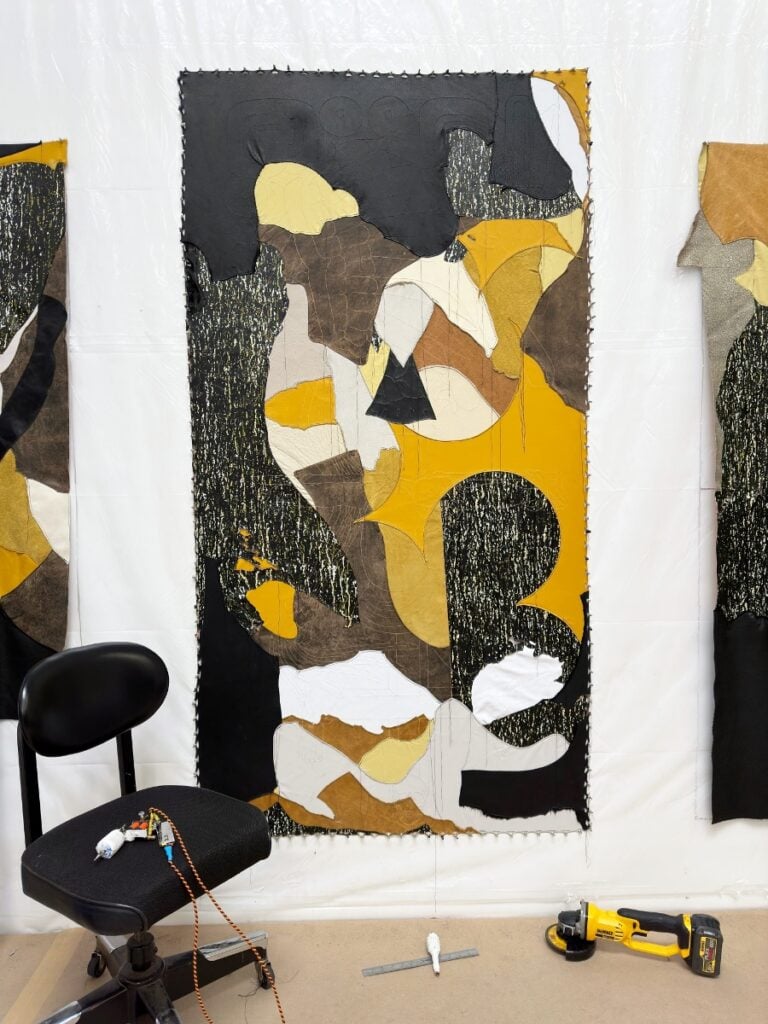Esteban Ramón Pérez – Under Your Fate (Bet I’ll Be Damned)

Galleria Poggiali presenta Under Your Fate (Bet I’ll Be Damned), prima mostra personale dell’artista statunitense Esteban Ramón Pérez (1989, Los Angeles).
Comunicato stampa
Galleria Poggiali presenta Under Your Fate (Bet I’ll Be Damned), prima mostra personale dell'artista statunitense Esteban Ramón Pérez (1989, Los Angeles), aperta al pubblico dal 4 aprile 2024 in Foro Buonaparte 52, Milano.
L'immaginario di Pérez e' abitato da elementi tratti dalla sua personale eredità culturale Chicana. Nella sua opera elementi biografici ed esperienze sociali si mescolano a suggestioni e iconografie della storie dell'arte.
Figlio del proprietario di un negozio di tappezzeria, cresce sperimentando le diverse proprietà dei tessuti. L’esperienza in bottega ne influenza fortemente l'opera, caratterizzata dall'impiego di materiali come cuoio, velluto, piume e fibre naturali. La sua pratica artistica inizia con il recupero degli scampoli scartati da negozi simili a quello del padre, sartorie e industrie del settore tessile.
In particolare, le tecniche di lavorazione del cuoio, tramandate per generazioni fino a diventare parte integrante dell'espressione culturale della comunità messicana, giocano un ruolo significativo nella sua produzione.
Un patchwork di pelli compone la base delle opere, a volte teso su telai artigianali, a volte appeso alla parete a mo’ di arazzo. La loro superficie e' attraversata da collage iconografici che, incisi sulla pelle, richiamano l’estetica del Rasquachismo e i tatuaggi tipici della Lowrider Culture.
Con Under Your Fate (Bet I’ll Be Damned) Esteban Ramón Pérez presenta un progetto composto da 9 opere inedite in grado di aprire uno scorcio sui nessi tra la cultura visuale chicana e la storia dell'arte italiana.
Ho iniziato a indagare sulla pittura e la scultura del primo e massimo Rinascimento, intorno al tempo in cui Cristoforo Colombo stava arrivando nel nuovo mondo per caso. Ho trovato un dipinto di Tommaso del Mazza dell'Annunciazione, con l'angelo che porta notizie a Maria della sua gravidanza, e la sua importanza. Ho messo a confronto una figura della morte, o una falce dietro l'angelo che porta cattive notizie, come un simbolo di presagio di ciò che verrà a causa di questo intervento divino e della diffusione della religione e della cultura occidentale.
Chance Encounters (The Annunciation) (2024) richiama esplicitamente l'Annunciazione di Tommaso Del Mazza, artista toscano del XIV secolo, conservata J. Paul Getty Museum di Los Angeles. Pérez reinterpreta la scena eliminando la figura della Vergine, con l'Arcangelo Gabriele armato che alza la mano a benedire qualcuno fuori dal nostro campo visivo.
Elementi dell'immaginario cristiano tornano in Corona (Heavy Is the Head) (2024), dove un volto simile a una maschera tribale appare sulla superficie dell'opera quasi fosse un sudario, circondato da una corona di spine.
Ho cominciato a riflettere su come le entità coloniali abbiano strumentalizzato la religione e l'autoattribuzione di una chiamata divina per la diffusione del cristianesimo nel mondo, giustificando in tal modo guerre e atrocità nei confronti dei non credenti, il tutto alimentato da una compulsione radicata nella fede.
Il continuo gioco di rimandi tra le due tradizioni culmina con l'opera di grandi dimensioni The Blood of Christ on Their Hands (Nepantla) (2024). Nepantla è un'antica parola nahuatl che significa "nel mezzo". Alcuni attribuiscono il concetto direttamente agli Aztechi colonizzati, altri all'antropologo Miguel Leon-Portilla (1926–2019) che fu il primo a scriverne. Nell'uso contemporaneo, il termine si riferisce spesso all'essere tra due culture, in particolare la propria cultura d'origine e quella dominante. In questo senso il Nepantla può essere inteso come uno spazio liminale, dove molteplici forme di realtà sono viste contemporaneamente e la multiculturalità è intesa come un prezioso strumento di cambiamento politico.
L'espressione "Sotto il tuo destino" che da' il nome alla mostra richiama l'idea di essere "Sotto il tuo incantesimo" o "Sotto il Suo occhio vigile". Questa associazione ha ispirato la mia riflessione sull'idea del destino come conseguenza della convinzione di un credente che sia la volontà predeterminata di Dio far sì che certi eventi accadano in un modo specifico. Credo che questa fede nel destino possa influenzare in modo significativo la sorte di qualcun altro, specialmente di coloro che non condividono la stessa convinzione, considerandolo un elemento di sfortuna.
Esteban Ramón Pérez vive e lavora a Los Angeles. La sua opera è inclusa nelle collezioni permanenti di Museum of Contemporary Art, Los Angeles e Pérez Art Museum Miami.
Galleria Poggiali presents Under Your Fate (Bet I’ll Be Damned), the first solo exhibition of American artist Esteban Ramón Pérez (1989, Los Angeles), open to the public from April 4, 2024, at Foro Buonaparte 52, Milan.
Pérez's imagery is inhabited by elements drawn from his personal Chicano cultural heritage. In his work, biographical elements and social experiences blend with suggestions and iconographies from art history.
As the son of an upholstery shop owner, he grew up experimenting with the various properties of fabrics. His experience in the workshop strongly influences his work, characterized by the use of materials such as leather, velvet, feathers, and natural fibers. His artistic practice began with the recovery of scraps discarded by shops similar to his father's, tailoring shops, and textile industry outlets. In particular, leatherworking techniques, passed down for generations until they became an integral part of the cultural expression of the Mexican community, play a significant role in his production.
A patchwork of skins forms the basis of his works, sometimes stretched on artisanal frames, sometimes hung on the wall like tapestries. Their surface is crossed by iconographic collages that, engraved on the leather, evoke the aesthetics of Rasquachismo and the typical tattoos of Lowrider Culture.
With Under Your Fate (Bet I’ll Be Damned), Esteban Ramón Pérez presents a project composed of 9 unpublished works capable of shedding light on the connections between Chicano visual culture and the history of Italian art.
I began to investigate the painting and sculpture of the early and high Renaissance, around the time Christopher Columbus was accidentally stumbling upon the New World. I found a painting by Tommaso del Mazza of the Annunciation, with the angel bringing news to Mary of her pregnancy and its importance. I juxtaposed a figure of death, or a scythe behind the angel bringing bad news, as a symbol of foreboding of what is to come due to this divine intervention and the spread of Western religion and culture.
Chance Encounters (The Annunciation) (2024) explicitly recalls the Annunciation by the pre-Renaissance artist Fra Angelico, preserved in the convent of San Marco in Florence. Pérez reinterprets the scene by removing the figure of the Virgin and representing an armed Archangel Gabriel raising his hand to bless someone out of our field of vision.
Christian imagery returns in Corona (Heavy Is the Head) (2024), where a face resembling a tribal mask appears on the surface like a shroud, surrounded by a crown of thorns.
I began to reflect on how colonial entities have instrumentalized religion and self-attribution of divine calling for the spread of Christianity worldwide, thus justifying wars and atrocities against non-believers, all fueled by a compulsion rooted in faith.
The continuous interplay of references between the two traditions culminates in the large-scale work titled The Blood of Christ on Their Hands (Nepantla) (2024). Nepantla is an ancient Nahuatl word meaning "in the middle." Some attribute the concept directly to the colonized Aztecs, others to the anthropologist Miguel Leon-Portilla (1926–2019) who was the first to write about it. In contemporary use, the term often refers to being between two cultures, particularly one's original culture and the dominant one. In this sense, Nepantla can be understood as a liminal and multicultural space, where multiple forms of reality are simultaneously seen and can become a tool for political change for those who consciously experience it.
The expression "Under Your Fate" - which gives the exhibition its name - evokes the idea of being "Under Your Spell" or "Under His watchful eye." This association inspired my reflection on the idea of fate as a consequence of a believer's conviction that it is God's predetermined will to make certain events happen in a specific way. I believe that this faith in fate can significantly influence the fate of someone else, especially those who do not share the same belief, considering it an element of misfortune.
Esteban Ramón Pérez lives and works in Los Angeles. His work is included in the permanent collections of the Museum of Contemporary Art, Los Angeles, and the Pérez Art Museum Miami.



